Apple's 2010 MacBook Air (11 & 13 inch) Thoroughly Reviewed
by Anand Lal Shimpi on October 26, 2010 10:08 PM EST- Posted in
- Mac
- Apple
- MacBook Air
- Laptops
The SSD: Not Half Bad
Apple advertises the new MacBook Air as being instant on as a result of the internal SSD. That’s mostly untrue. From a completely powered off state the MacBook Air still takes time to boot. That time is significantly reduced compared to the old MacBook Air and any other Mac with a conventional hard drive. It’s even a shorter boot than my MacBook Pro with a SandForce SF-1200 based SSD in it:
| System Performance Comparison | ||||||
| Boot | Shut Down | Sleep | Awake | |||
| 11-inch MacBook Air | 15.5 seconds | 2.2 seconds | 1.0 second | 1.63 seconds | ||
| 13-inch MacBook Air | 14.4 seconds | 1.9 seconds | 1.0 second | 1.56 seconds | ||
| 13-inch MacBook Air (Late 2008) | 34.4 seconds | 2.9 seconds | 1.6 seconds | 4.19 seconds | ||
| 15-inch MacBook Pro (SF-1200 SSD) | 19.1 seconds | 1.8 seconds | 1.5 seconds | 2.3 seconds | ||
| 15-inch MacBook Pro (Mid 2009, HDD) | 34.2 seconds | 2.8 seconds | 1.8 seconds | 2.1 seconds | ||
You'll notice that even the SF-1200 SSD in my 15-inch MacBook Pro takes longer to boot than these new Airs. Apple does customize the firmware on its SSDs. I’d be willing to bet the SSD in the MacBook Air has tight integration with OS X to guarantee quicker than normal boot times.
Clearly the new Air isn't instant on from a boot standpoint, but it's pretty much there from a recover-from-sleep standpoint. The new Airs both go to sleep and wake up from sleep quicker than any of the other Macs, including my upgraded 15-inch Core i7 MacBook Pro. Again, nothing can trump Apple's tight integration between hardware and software.
Apple likes to work with two different controller manufacturers for SSDs: Samsung and Toshiba. iFixit already confirmed Toshiba is in the new MacBook Air with its teardown:
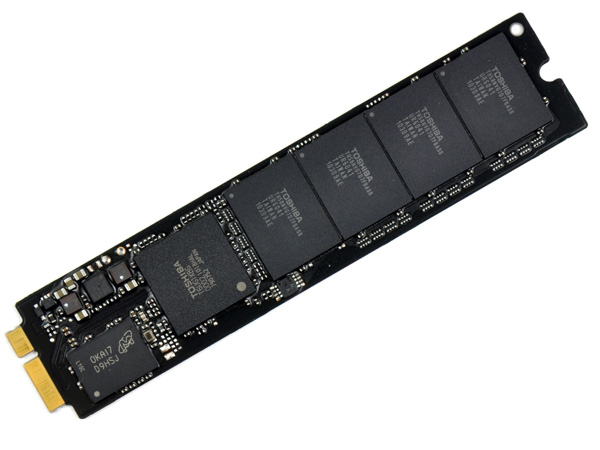
The 11-inch MacBook Air SSD, courtesy of iFixit
The SSD isn’t in an industry standard form factor, although the connector appears to be either micro or mini SATA. Presumably 3rd party SSD manufacturers (ahem, SandForce partners I’m looking at you) could produce drop in replacements for the MacBook Air SSD.
There’s nothing particularly innovative about the form factor of the SSD, other than Apple did away with the unnecessary space a 2.5” SSD would require. Just as SSDs will break the traditional SATA interface barriers, we’ll see the same happen to form factors as well.
The part number on the Toshiba controller may look familiar to some of you. It’s the same controller that’s in Kingston’s SSDNow V+ Series and the SSDNow V Series Boot Drive. I reviewed the latter not too long ago and found that it was a good drive for the money, and here’s the kicker: the SSDNow V Series Boot Drive was amazingly resilient when written to without TRIM support. Its performance hardly dropped as a result of normal desktop use. This is very important because although OS X 10.6.4 has a field for reporting TRIM support on an SSD, the instruction isn’t actually supported by the OS. Even the new MacBook Airs don’t ship with a version of OS X with TRIM support.
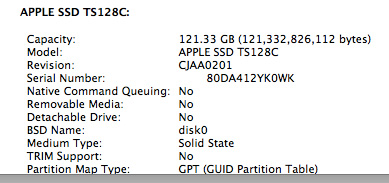
The SSD only has four NAND devices on it. Typically that would mean some very low transfer speeds, particularly on writes. But each one of those four devices has at least 16GB of NAND, spread across multiple planes and die. With the right firmware, you should be able to extract a good deal of parallelism from this architecture. Apple and Toshiba apparently do just that.

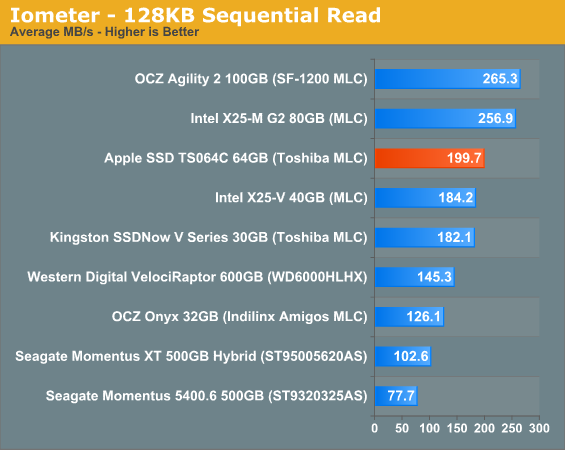
While most value SSDs top out at under 100MB/s, we get nearly 200MB/s sequential reads and writes out of the SSD in the new MacBook Air. And fortunately, Apple hasn’t only focused on sequential performance. The random read/write performance of the new MacBook Air SSD isn’t terrible:
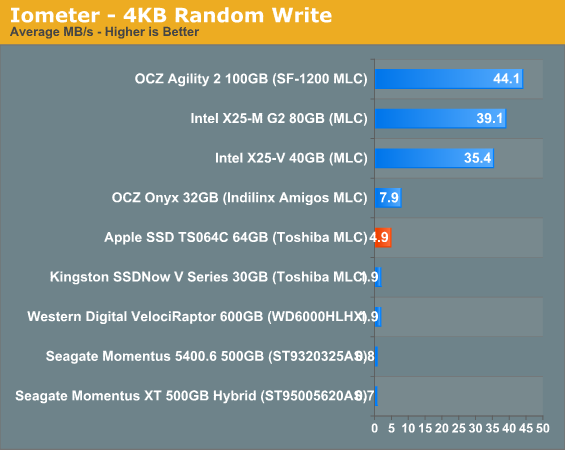
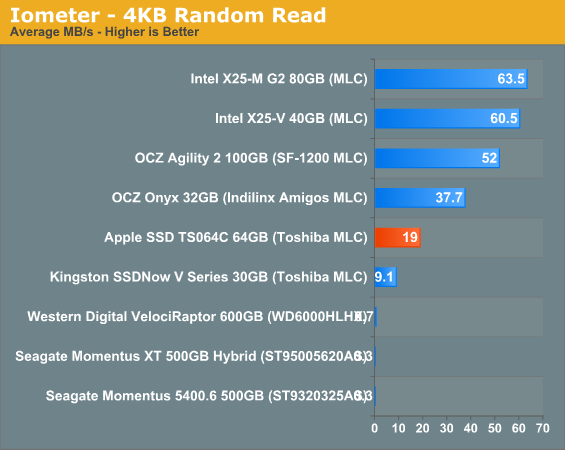
Random write performance is of course the weak point, but you’ll notice that it’s actually higher than the Kingston drive that uses the same controller. While Apple would’ve been better off striking a deal with Intel or SandForce for the controller in the MacBook Air, the Toshiba controller isn’t horrible.
As I mentioned earlier, resilience is very important as OS X still doesn’t support TRIM. I filled the drive with garbage and then tortured it for 20 minutes with random writes. The resulting performance drop was noticeable, but not unbearable:
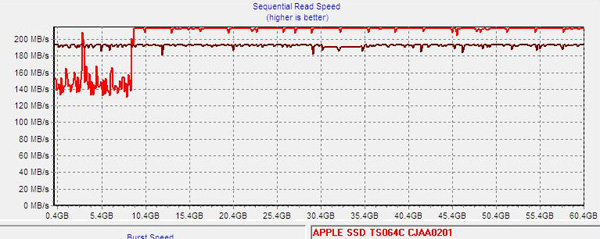
A single pass of sequential writes restores performance to normal:
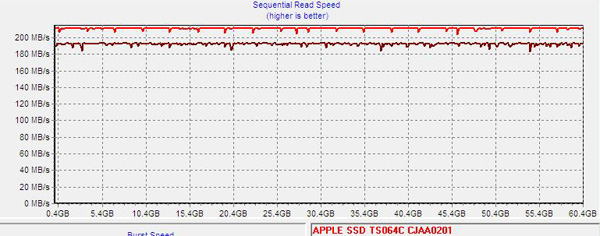
This tells us two things. First, through normal use the drive should be able to recover its performance over time (assuming you give it enough spare area). And second, if there’s any idle garbage collection in Apple’s custom firmware for the Toshiba controller it should be able to keep the drive running at peak performance even without TRIM supported in the OS. I don’t have a good way of measuring whether or not there’s GC enabled on the drive in OS X, but I suspect Apple is (at least it appears to be doing so on the Mac Pro’s SSDs).
Overall I’m pleased with Apple’s SSD selection. It could’ve been a lot better but it could’ve been a lot worse. The MacBook Airs in their default configuration have better IO performance than any other standard config Mac sold on the market today, including the Mac Pro.










185 Comments
View All Comments
VanHoward - Wednesday, October 27, 2010 - link
Instead of "jives with" should be "jibes with" ...Exelius - Wednesday, October 27, 2010 - link
I'm a huge Apple fan - but I'm just not drinking the kool-aid on this one.I have a 15" MBP and it's really not that bad to carry around. It also gets like 5-8 hours of battery life (3-4 with VMWare running) and it runs Windows 7 under VMware very well with 8 GB of RAM. I've never considered portability an issue and while it's an expensive machine, I don't think you'd own an MBA. I doubt the MBA would have nearly that type of battery life under VMWare.
The iPad seems like a better form factor for the "couch computer" (i.e. looking up shit on IMDB or googling something to settle an argument while watching football.)
IMO the MBA seems like a poor man's MBP. i.e. for students looking for a cheaper computer; the "super-thin" part seems almost like a gimmick to convince people it's a premium product. Really, the only drawback of the 15" MBP (even the lowest-specced one) is the price.
joe_dude - Wednesday, October 27, 2010 - link
The thing's hardly faster than my Ion netbook. There will be lots of thin designs coming out like what Intel showed at Computex. Core 2's two generations behind.For now, I think the Acer TimeLineX 3820TG is still the best ultraportable laptop (certainly the fastest anyway).
zsero - Wednesday, October 27, 2010 - link
As for an alternative for sub 5 lbs powerful laptops and as for the M11x being fast: I am typing this line on a Acer TimelineX 3820TG with 450M and switchable HD5650, which is on a totally different level than either the MBA or the Dell (while being half the price).- 3.9 lbs
- it can do 9000-10000 points in 3dmark06 easily with a little bit of raised clocks (one click in AMD GPU tool). In games it's even faster, as the ATI cards are much better in real games than in benchmarks.
- if you are lucky, you can overclock CPU to 3.3 Ghz (or swap to a 580M and OC-it to 3.8 Ghz, with sub-75C temperatures!)
- and easily do 6-8 hours while web surfing
- has dual fan / dual heatpipe cooling
Other than that, it has the most horrible keyboard I have ever seen, with a cheap AUO screen, noisy mic and poor warranty service and a gazillion of running applications, including two real-time virus scanners on the factory install. But a review would be really interesting to see! I seriously think the 3820TG with HD5650 is without alternative in the powerful but portable notebooks, if possible, please make a review about it! (in North America, I think it's only available with 370M processor, while in Asia they sell it with anything up to 640M).
khimera2000 - Wednesday, October 27, 2010 - link
Intresting system, but i wouldent use it. the keyboard looks to have flex under light loads, making me think that although it looks great on the outside the inside might of had to make some structual sacrifices for the bigger specs, not to mention that the lack of a backlit keyboard would make it more inconveniant compared to what i have now.But it does like they are trying to improve there build quality, its just not to the point that i would like.
As nice as the specs are, i just cant bring myself to trust there build quality just yet, however it does look like there at least trying to improve so who knows perhaps there will be an acer on my list of potentials the next time im do for a notebook upgrade.
as for comparison to the air... i think there oppisets in some respects. the air's performance although weak at best can still fit in nearly any bag making it conveniant to find a place to stow it for those who have bags full of books and junk, where as the acer trys to push for a more heavy multimedia experiance with a good compact form facter and a extended battery.
lemonadesoda - Wednesday, October 27, 2010 - link
1/ SD card reader2/ mic on front for skype/VoIP
The 11" netbook would be a absolute winner (and an order of magnitude upgrade for people using Atom netbooks) . But why did they miss the SD card reader? This is so obvious, and a determining feature what makes one brand/model of netbook a winner over another brand/model. Such a simple and cheap port. Even the iPad has an SD card reader!
And what on earth are they doing putting the mic on the side like that? While it *might* be OK when sitting indoors at a tidy desk without other ambient noise, it certainly is not clever in most "real world" situations.
I would love to replace my ever-so-slightly too noisy and underpowered (but magnificent screen and full of ports) SONY W11 netbook. But no, not until Apple fix the mic location and provide an SD slot.
(I use SD slot for camera - saving local or uploading to fileserver/website, for camcorder - and immediate playback of material recorded, for old-fashioned mailing of data/documents, for a TASCAM HQ digital audio recorder, and for file transfer with colleagues and for file backup when out of the office, I need highest possible robust mic for indoor and outdoor skype/VoIP where my office telephone is forwarded to my laptop through SIP )
These two points may seem like tiny features, but I think for many people they are showstoppers.
johnspierce - Wednesday, October 27, 2010 - link
I'm not sure why everyone thinks an SD card slot is a "must have". For one thing, there are still quite a few cameras that *don't* use SD cards (like virtually any high-end DSLR) and putting a technology in your laptop that might not even be viable in 3-5 years is not exactly a good idea. Buy a 9-in-1 card reader. They are like $20. They are about the size of a deck of cards and can handle almost any type of flash.I would MUCH rather have a 3.0 USB than a SD card slot -- infinitely more useful.
kmmatney - Wednesday, October 27, 2010 - link
SD slots are useful for permanent storage. I have an 80GB SSD in my Dell Inspiron 9400 laptop, but needed a little more storage. So I just keep a 32 GB card in the SD slot, and it gave me enough room for everything I need. I use it mainly for documents, presentations, and backups of important work from teh SSD. It only sticks out about 2 mm, so I can keep it on all the time. I've even run VMware images from it, and it wasn't too bad.I agree that a USB 3.0 slot is useful as well, but wouldn't want to lose the SD slot - its like having a second, easily removable, hard drive.
khimera2000 - Wednesday, October 27, 2010 - link
I see it as a replacemenct for the optical drive, since its also used in cameras, video recorders, and ebook readers (i have an SLR that uses these and a ebook) it makes them alot more conveniant since most notebooks come with the slot already. it puts the macbook at a disadvantage becaus now people have to carry around a card reader that would not be neaded on other notebooks.It would be such an inconveniance if i had to drag around a reader with me, and since alot of apple users do photo and video editing it looks like a bad oversight not being able to transfer images and videos without extra required hardware.
Stuka87 - Wednesday, October 27, 2010 - link
So I am posting late here. I read this last night, but was too tired to respond.So now a lot has already been said. But here is one thing that keeps boggling me.
WHY do people keep calling this a Netbook when it clearly *IS NOT*. The 11.6" MBA is an ultraportable. In line with other ultraportables out there. Its not a cheap piece of plastic with a laughable screen, keyboard, graphics, or atom processor. The benchmarks clearly show this machine to run circles around an atom.
And if you compare it to similar machines of weight, size, and speed its not far off the mark from a price concern either.
Is it a perfect machine, no... But it looks like it will fill the gap that has been missing from the Apple product line since the demise of the 12" PowerBook.